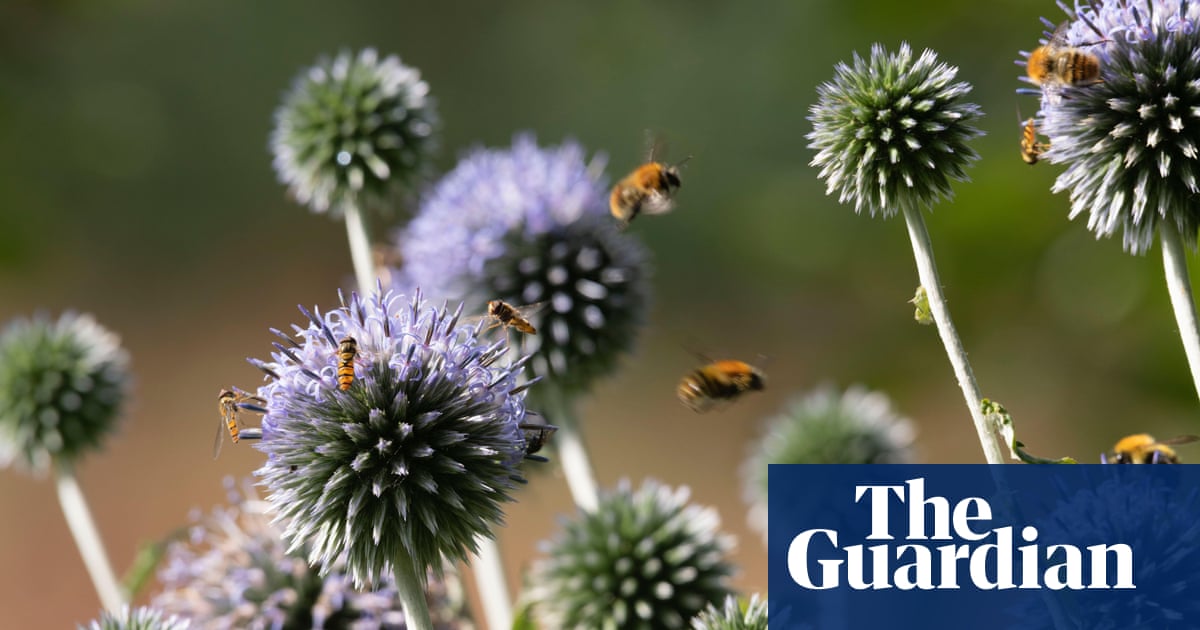Prof Lynn Dicks has had her hands in the soil for almost three decades â and she has watched it slowly become stripped of invertebrate life.
âIn my life, I have seen the decline,â says Dicks, an ecology professor at the University of Cambridge. She knows it from the data: âThe data we have of long-term trends in insect abundance over time, that the decline rates are, on average, about 1% a year.
But she sees it, every day, as well. âThere are fewer insects just flying around. When you leave the window open and the lights on at night, you donât get flooded with them any more like you used to.â
Dicks has spent her lift trying to work out why, exactly, the UKâs insect populations are nosediving before it is too late to stop species being lost for ever. And pesticide use â the pesticides that farmers have been using on crops for decades â are one of the key factors.
While farming groups say the weight of pesticides used in the UK has halved since 1990, scientists and campaign groups say this is not an accurate measurement of chemical usage. This is because the types of chemicals used have become more toxic and the area of land treated with pesticides has increased.
Pesticide Action Network says some modern pesticides are 10,000 times more toxic than DDT, a notoriously noxious chemical that was banned for its impact on human health and the environment.
And we still donât know the effects these cocktails of chemicals have on insect ecosystems, pointed out Nick Mole, policy officer at Pesticide Action Network UK. âHundreds of different pesticides are used to grow food in the UK. As a result, pesticides appear in millions of different combinations in varying concentrations in our landscape. However, safety assessments are only carried out for one chemical at a time. There is little to no understanding of how these pesticides interact with one another to affect soil, water and biodiversity. Much more research needs to be undertaken to understand this properly.â
Dicks said: âThe wild insects are being exposed to a very wide range of pesticides as they go about their lives. And itâs fungicide, herbicides, molluscasides, insecticides, a whole cocktail of different things. In fact, a recent European study on bumblebees, showed an average of eight different chemicals in the pollen stores collected by bumblebees, and up to 27 different pesticides being collected.â
Governments also donât legislate for combinations of toxic chemicals, she explains, adding: âWe donât really know how this is affecting insects more widely. I would say itâs affecting them. In that European study on bumblebees, they could measure the exposure. They call it the pesticide risk, but itâs basically a measure of the exposure to pesticides thatâs weighted by their toxicity, and that measure predicted the number of bumblebee queens that could be produced, the number of bees in the colonies, and the way the colonies grew. In fact, the most exposed colonies produced 47% fewer queens than those that were least exposed.â
The State of Nature report, conducted in 2023, found insect numbers crashing. âPollinating insects (bees, hoverflies and moths), which play a critical role in food production, show an average decrease in distribution of 18% since 1970. Predators of crop pests (ants, carabid, rove and ladybird beetles, hoverflies, dragonflies and wasps) showed an average decrease in distribution of 34%â.
Max Barclay, the curator of beetles at the Natural History Museum in London, said he had also noticed a decline: âI examined horse dung at the weekend in Sussex, and found it was entirely devoid of dung beetles and their larvae and was just lying on the pasture in its original shape for weeks instead of being broken down into the soil. This has potential long-term consequences for soil health and fertility. Intact piles of dung all over a pasture is not something I have experienced when I was starting out in beetle studies in the 1980s and 90s, but now is a commonplace sight.â
He said the pesticides used in livestock farming were decimating beetle populations: âIvermectin and associated worming drugs used routinely for sheep, cattle and horses can have a devastating effect on dung beetle faunas, which are important for recycling nutrients into the soil and through their burrowing for soil aeration.â
after newsletter promotion
And unlike with crop pesticides, the issue is getting worse and the worming drugs are more frequently used. âIvermectin has been available since the 1970s but recently there has been a cultural change, from worming animals when needed, to administering regular worming doses whether or not there is evidence of worms. This means that the dung and pasture is permanently contaminated with toxic chemicals.â
Ali Karley, Jenni Stockan and Cathy Hawes, respectively an agroecologist, an invertebrate specialist and an ecologist working in arable biodiversity at the James Hutton Institute said they had also noticed beetle declines.
They said: âFrom our Environmental Change Network data at our Glensaugh research farm, a hill farm in north-east Scotland, weâve seen a reduction of about 70% in ground beetle abundance over 30 years, although this number varies with habitat. The biggest declines are in bog heathland and the least in grassland.â
They said pesticide use could be reduced with a technique known as integrated pest management, which âseeks to use natural predators or parasites to control pests, using selective pesticides for backup only when pests are unable to be controlled by natural means. Itâs important to adopt an integrated approach to enable pesticide reduction without increasing risk.â
Some farmers are doing this already. Dicks said she felt optimistic about the future, with many farmers ceasing to use insecticides.
âIâm quite optimistic that we can change and that we can reduce pesticide use in all of our farmland,â she said, âBut it does take goodwill, and itâs going to take supporting farmers to do that, and getting research to show a positive effect of that transition on insects in the real environment.â



